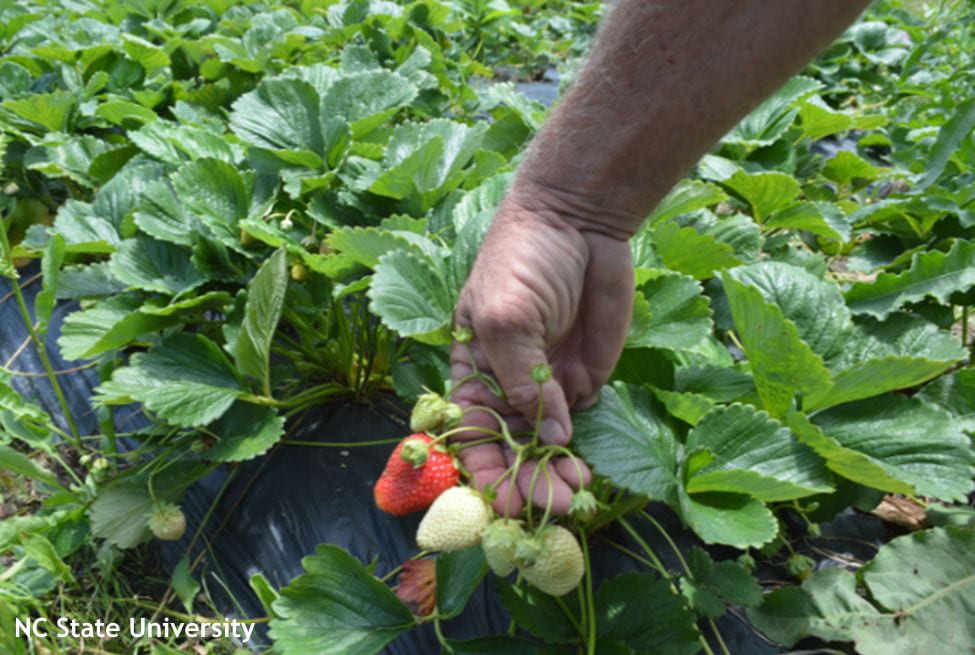Gordon Johnson, Extension Vegetable & Fruit Specialist; gcjohn@udel.edu
There is significant interest in the use of repeat blooming strawberries for extended production. These “day neutral” varieties can provide good spring production with continued production into the summer and fall, depending on the planting date. Day neutral strawberries are different from spring bearing types because they are not triggered to flower by daylength and can flower and fruit repeatedly as long as temperatures are suitable. Day neutrals vary in their ability to flower during the summer, and have been classified as either weak or strong. Strong day neutrals produce flowers and runner sparsely during the summer, flowers form on runners, and plants tend to be small with a moderate number of crowns. Intermediate and weak day neutrals, have more of the spring bearing characteristics, such as a stronger tendency to runner in summer. We recommend strong day neutrals for summer and fall production in our area.
In research at the University of Delaware, the California bred variety Albion has shown good promise as a day neutral with large firm berries, small plants, and long term, even production. It is lower yielding than others but works well in our region. Albion can be spring planted and fruited starting in June through early July with production again at low levels in the fall, summer planted for late summer, fall and spring production the following year or September planted for April through early July production (again with some lower production in the following fall). Because Albion has fewer crowns than other varieties, it may be planted at a higher density. We find that three rows per bed with 2 drip tapes between is a productive system. In addition, because these day neutral varieties produce over a long period, additional nitrogen is needed to maximize production.
Another California bred variety that has worked in our area is San Andreas. The planting windows are similar to those for Albion above; however San Andreas will have higher fall production and heavy production the following spring.
These day neutral varieties are susceptible to anthracnose, so targeted fungicide programs should be used for control.
To summarize, these day neutral varieties can be planted in the spring for summer, fall and carryover spring production; planted in summer for fall and carry over spring production; and planted in fall for spring, summer and fall production the next year.
The USDA at Beltsville Maryland is working on breeding improved day neutral varieties for our region and we are looking forward to releases in the future.
An alternative production system has also been tried in the region. In this system, monthly plantings of day neutral varieties are made starting in March and going through September. While costly, this ensures that there is a peak production period occurring throughout the season. All plantings can then be overwintered and fruited the following spring. The variety Seascape has been used in these systems.
For summer production with day neutral varieties, the use of white or aluminized reflective plastic mulch with drip irrigation is recommended. Additional provision for heat abatement will be necessary. This may include low volume misters for evaporative cooling during hot daytime temperatures or the use of shade cloth. Drip irrigation should be run during the day to further limit bed heating.
Remove runners from all plants throughout the season. This task is somewhat intensive early in the season and again during hot weather in July, but runnering decreases markedly during fruiting.
Flowers should be removed for 6 weeks following planting to allow the plants to achieve sufficient size for fruiting. Failure to remove flowers will result in small plants and low yields. Extending the period of flower removal beyond 6 weeks will result in larger plants, berries and second-year yield, but less production in the first year. Varying the flower removal period will not affect the timing of production peaks.
Day neutrals benefit from a continuous supply of nitrogen and potassium. Additional phosphorus is not necessary, provided an adequate supply has been incorporated before planting. Apply 5 to 6 lbs/A of nitrogen through the drip irrigation system every week. Calcium nitrate is the preferred source of nitrogen early in the season, UAN solution can be substituted when temperatures warm. Supplement preplant potassium with 10 lb/A of K2O at monthly intervals, or 2 lb/A at weekly intervals through the drip irrigation system during the growing season. Day neutrals tend to be heavy consumers of boron because of their large commitment to reproduction. Monitor leaves occasionally to ensure that boron levels do not fall below 30 ppm. An application of 2 lb/A Solubor may be required in midsummer if boron levels are too low.
Gray mold is the biggest disease problem of day neutral strawberries. Because berries are continuously present, mold inoculum tends to increase during the season. Remove moldy berries from the planting and protect flowers every 10 days to 2 weeks with an application of fungicide, especially after rainy periods.
To extend production in the fall, floating row covers, clear row covers, or a combination can be used to conserve heat. If fall production is to be targeted, mid-summer plantings on black plastic mulch would be recommended but overhead irrigation is essential for establishment. Day neutral varieties also have potential for extended production in high tunnels.
As stated before, day neutral plantings can be carried over to a second year. Spring planted crops should be cut back in late summer and crown thinning may be necessary in some varieties.

Repeat blooming day-neutral Albion strawberry.
